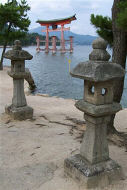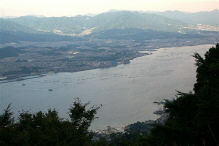48 Hours in Hiroshima
Hiroshima, Japan
Bleary-eyed and under-slept on a cool Saturday in September, I awoke at the crack of dawn, grabbed my backpack, and cycled furiously down narrow, winding streets to catch an 8AM train bound for Hiroshima, a city full of old memories and modern wonders.
At 4PM, the train conductor tapped me gently on the shoulder and whispered something in Japanese. Being unable to comprehend little more than “Konnichiwa,” my instincts told me to smile a “thank you” at this kindly old gentleman and take a quick look at my surroundings. Soon, I saw a sign posted in English, and a huge smile crept onto my face.
Welcome to Hiroshima.
I was alert and agile from my eight-hour nap, hopping off the train to whip out my handy travel survival guide. As soon as I figured out my bearings, I got onto a streetcar and eagerly headed towards the Hiroshima Peace Park. Having learned extensively about Hiroshima during my years and years of history training, it became a goal of mine to visit the city one day.
On my way to the park, I took in the vibrant sights and sounds that make Hiroshima the beautiful, thriving metropolis that it is today, full of tall buildings, wide roads, streetcars, and eye-catching trendsetters scurrying off in every imaginable direction. I found it harder and harder to believe that years before this stylish, urban centre took its present-day form, Hiroshima was reduced to little more than smoke, ash, and rubble.
Several minutes later, I got off the streetcar and headed for the war memorials, mostly located in the middle of Hiroshima’s two intersecting rivers. Near the centre of the rivers’ two crossings lies Shima Hospital, once the site of the A-bomb explosion.
The park is home to an undying flame, resolved to burn until nuclear weapons become nothing more than reminders of a painful, violent past. Sadako, the little girl known the world over for folding over a thousand paper cranes before her succumbing to leukemia, has also found a home here, in the form of a children’s monument that pays homage to her memory.
Of all the unforgettable sights in Hiroshima, those that strike me the most are found at the war museum. The horrific images of the victims ravaged by war, and the severity of their wounds, are painful to witness, and the numerous photos and video footage leaves me silent and remorseful. I took my time looking at every broken dish, melted glass bottle, article of clothing, my feelings of sadness growing more profound with every deformed remnant I examined.
I was brought to a standstill by a pair of watches whose hands froze in place on the morning of the bombing, August 6, 1945. They point to 8:15. Mementos of an immortalized time.
By the time I left the museum, the sun had already sunk beneath the horizon. I noticed a slight sense of fear creeping into my over-indulged mind, falling prey to the ominous feel that is emanated by the city after sundown. On clear evenings, the sky casts hazy shadows over the outdoor statues, creating a series of towering, three-dimensional silhouettes, waiting impatiently to burst forth with life.
Despite my mounting fear, I set out for the A-bomb dome, my final must-see destination. The A-bomb dome, known as the Genbaku Dome to the Japanese, is the only building left standing after the war. Although it was dark out, faint orange spotlights implanted in the foliage lit up the remains of the building. These concentrated patches of light gave the dome an eerie air, and it conjured up thoughts of lingering spirits and spooks, restless and wandering, unaware of the years that have passed. Illuminated from the inside, the dome resembled a brick corpse whose crumbling façade was lit by the glow of fading embers. A reminder of Hiroshima’s painful past – a destructive onslaught, slow to heal, never forgotten.


Miyajima’s Famous Torii
![]()
![]()
Thirty-two hours into my weekend, I visited Miyajima Island, located in the heart of Japan’s Inland Sea.
Like every over-hyped tourist attraction, Miyajima Island was packed with visitors. Ferries carried boatloads of people onto the island every 15 minutes. There were three times as many people wandering about as there were blasé-looking deer. Miyajima is home to scores of lazy, domesticated deer, who eke out their existence by eating the feed that amused tourists offered on their outstretched palms.
I shooed away some wayward deer – who have perfected the “feel sorry for me, I’m a helplessly cute animal” look that they use on all the tourists – and snapped some pictures of the island’s famous “floating” torii, a distinctive entranceway to a Shinto shrine. At high tide, the torii is surrounded by water and looks as though it was set afloat. When the tide ebbs, the torii stands in a murky brown puddle, looking as sorry as a toilet-training toddler standing in his messy creation.
Next, I headed to Miyajima’s main attraction, Itsukushima shrine. A traditional Japanese wedding was taking place in the main hall, giving tourists like myself more reason to gawk in wonder at the sights of the Nihon-themed Disneyland that lay before us.
The wedding music was cacophonous and discordant (woodwind-type instruments that sounded like flattened kazoos set the backdrop for the ceremony) and the eyes of the guests were beginning to droop. A few of the invitees took more interest in the tourists snapping pictures than the actual wedding, often sneaking glances at the crowd of gaijin congregated at the back of the room. One person’s boredom is obviously another’s fascination! Nevertheless, it was interesting to see a traditional Japanese wedding. Not exactly a common sight in the outreaches of my “exotic” nest, Toronto.
As I walked through the shrine, I caught sight of one of the Shinto priests decked out in a black, box-shaped hat and flowing white robes accented with a light blue sash. I asked if I could take my picture with him. Before he complied, he took out a long, wooden paddle and held it in his hands like a drawn sword. Then he nodded his head authoritatively, letting me know he was ready for the picture. We snapped a quick picture before he hurriedly walked away, absorbed in the preparations for the wedding reception.
I felt as though I had stepped into some strange, ethno-flavoured amusement park and snagged a photo-op with a character from a period flick!


View from Mount Misen
![]()
![]()
With nothing to do and all the time in the world to kill, I decided to climb Miyajima’s tallest peak, Mount Misen. Also known as God’s mountain, Mount Misen is a steep 503m climb – definitely a challenge for a novice climber. However, I was up for a bit of exercise. The day was balmy and pleasant, the temperature hovered around 20°C, and I was feeling genki (strong, healthy).
As I puffed my way up the mountain, perky as the Energizer bunny, I came across a group of people seated at a rest station – a friendly retired Japanese man named Sagawa-sensei, Nicola, a fellow English teacher from New Zealand, and Allan, a comedic Australian. After our brief introductions of “Hello, where are you from?” the four of us decided to climb the rest of the way together.
It turned out that Sagawa-sensei was a retired high school English teacher and was keen on speaking the language to native speakers. What a godsend! We talked about everything under the sun, from Japan’s history to strange food delicacies to the weather in Canada, all of which gave us enough distraction to avoid acknowledging our tired, achy bodies and the increasingly steep slopes that slowed our progress towards the mountaintop.
Finally, after three hours and an endless conversation, we set foot atop the last rock. After several moments of oohing and ahhing, my fellow climbers and I congratulated each other for having accomplished “the mission,” as Sagawa-sensei had labeled our quest.
We all peered out onto the mainland from Mount Misen’s summit, in awe that the formerly huge surroundings had diminished into miniature dots of civilization – a meek contrast to the majestic set of mountains that outlined the city. We each felt euphoric, fit, and powerful, ready to conquer anything that life threw in our direction… that is, until Sagawa-sensei asked us the following:
“Shall we begin our climb to the bottom?”
Allan, Nicola, and I muffled our groans, hemmed and hawed, then politely nodded OK. After all, the climb to the bottom was inevitable and it was better to start sooner than later. By that time, the sun was already blanketed by heavy cloud cover and the thick, damp air warned us that rain was set to fall over the island.
To our pleasant surprise, it only took one third of the time to descend Mount Misen as it did to climb up.
Afterwards, my climbing partners and I exchanged our final “Senk yous” and “A-ree-ga-tos,” which, in traditional Japanese fashion, were accompanied by smiles and several bows.
I stood back and watched Allan, Nicola, and Sagawa-sensei retreat towards the darkened Miyajima torii, now surrounded by trigger-happy latecomers, mostly young couples, who braved the clumpy, wet mush for nighttime close-ups.
Lazily, I dragged my feet through the pebble-filled sand, taking my time as I made my way to the dock. I stared out into the Inland Sea and caught sight of the mainland, lurking silently in the distance.
I waited for a boat to take me to shore.